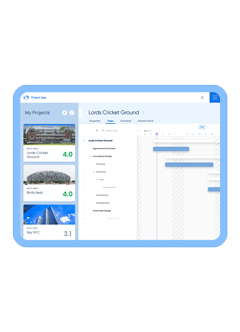Earned Value Management (EVM) is a technique well-suited for professional services organizations, yet many design consultancies struggle to harness it. However, through thoughtful use of process and technology, your consultancy can make EVM stick – and enjoy improved project delivery.
To help you succeed in this, here are five process and technology tips for implementing EVM in your consultancy:
1. Establish a project work breakdown structure.
A key component to EVM is establishing a work breakdown structure (WBS) for every project. Consider establishing WBS standards for the different types of projects you deliver, aligning with project deliverables. To best support EVM, a project WBS should go down to the level that Planned Revenue, Earned Revenue, and Actual Effort will be tracked.
2. Establish a project schedule.
To utilize EVM to track schedule performance, you need to establish project schedules. These schedules should reflect WBS sequencing, and how resources will be utilized to deliver the project. Additionally, these schedules should be divided into time periods (e.g. months, weeks, days) at a granular enough level for tracking schedule performance.
3. Calculate and baseline Planned Revenue.
After establishing the project WBS, determine Planned Revenue across the WBS. An integrated project management and accounting system with the right combination of project-centric capabilities can help you achieve this. To support EVM, a system should capture project labor and expense pricing terms, and leverage these terms along with a project resource plan to calculate Planned Revenue.
At a minimum, Planned Revenue needs to be established by WBS element, in order to utilize EVM to track project financial performance. If tracking project schedule performance is also an objective, then Planned Revenue should also be forecasted across the same time periods by which the project schedule is established.
4. Track Earned Revenue and Actual Effort.
Once project execution begins, track Earned Revenue and Actual Effort as labor and expense charges are posted to the project WBS. Here too, a project-based business system can assist, if it tracks these metrics in conjunction with timesheets, expense reports, and other project charges.
5. Track project performance and adjust Earned Revenue.
As Earned Revenue and Actual Effort accrue on a project, use additional EVM metrics to assess financial and schedule performance and determine when corrective action is necessary. In conjunction with this analysis, Project Managers may need to adjust Earned Revenue in alignment with project progress.
An EVM-enabled business system supports this by allowing project managers to update the physical percent complete of an entire project or specific elements of the project WBS. This percent complete assessment is then used to adjust the Earned Revenue via the following equation:
Earned Revenue = Planned Revenue x Physical Percent Complete
By following these tips, EVM can play a central role in driving better project delivery in your firm. By understanding how traditional EVM metrics apply to your business model, and incorporating these metrics into your project management processes and systems, your firm can take significant steps towards better financial and schedule performance across its project portfolio.
Author’s Note: This is the fourth article in a four-post series on the use of Earned Value Management in professional services organizations.









